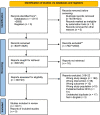The impact of mandatory waiting periods on abortion-related outcomes: a synthesis of legal and health evidence
- PMID: 35725439
- PMCID: PMC9210763
- DOI: 10.1186/s12889-022-13620-z
The impact of mandatory waiting periods on abortion-related outcomes: a synthesis of legal and health evidence
Abstract
This review follows an established methodology for integrating human rights to address knowledge gaps related to the health and non-health outcomes of mandatory waiting periods (MWPs) for access to abortion. MWP is a requirement imposed by law, policy, or practice, to wait a specified amount of time between requesting and receiving abortion care. Recognizing that MWPs "demean[] women as competent decision-makers", the World Health Organization recommends against MWPs. International human rights bodies have similarly encouraged states to repeal and not to introduce MWPs, which they recognize as operating as barriers to accessing sexual and reproductive healthcare. This review of 34 studies published between 2010 and 2021, together with international human rights law, establishes the health and non-health harms of MWPs for people seeking abortion, including delayed abortion, opportunity costs, and disproportionate impact. Impacts on abortion providers include increased workloads and system costs.
Keywords: Abortion; Cooling off periods; Mandatory waiting periods; Reflection periods; Reproductive rights; Sexual and reproductive health.
© 2022. The Author(s).
Conflict of interest statement
The authors confirm there are no applicable competing interests.
Figures

Similar articles
-
The impact of provider restrictions on abortion-related outcomes: a synthesis of legal and health evidence.Reprod Health. 2022 Apr 18;19(1):95. doi: 10.1186/s12978-022-01405-x. Reprod Health. 2022. PMID: 35436888 Free PMC article. Review.
-
Abortion law around the world: progress and pushback.Am J Public Health. 2013 Apr;103(4):585-9. doi: 10.2105/AJPH.2012.301197. Epub 2013 Feb 14. Am J Public Health. 2013. PMID: 23409915 Free PMC article.
-
The impact of criminalisation on abortion-related outcomes: a synthesis of legal and health evidence.BMJ Glob Health. 2022 Dec;7(12):e010409. doi: 10.1136/bmjgh-2022-010409. BMJ Glob Health. 2022. PMID: 36581332 Free PMC article. Review.
-
Do mandatory waiting periods for abortion increase intimate partner violence?J Health Econ. 2024 Dec;98:102939. doi: 10.1016/j.jhealeco.2024.102939. Epub 2024 Oct 28. J Health Econ. 2024. PMID: 39541695
-
Reproductive awareness and recognition of unintended pregnancy: young women, key informants and health care providers perspectives in South Africa.Reprod Health. 2021 Oct 26;18(1):211. doi: 10.1186/s12978-021-01262-0. Reprod Health. 2021. PMID: 34702283 Free PMC article.
Cited by
-
Abortion Surveillance - United States, 2022.MMWR Surveill Summ. 2024 Nov 28;73(7):1-28. doi: 10.15585/mmwr.ss7307a1. MMWR Surveill Summ. 2024. PMID: 39602470 Free PMC article.
-
Avortement au Maroc et virage au drame : femmes et professionnels de santé en parlent ! Une étude transversale mixte à Agadir.Sex Reprod Health Matters. 2023;31(5):2279371. doi: 10.1080/26410397.2023.2279371. Epub 2024 Jan 10. Sex Reprod Health Matters. 2023. PMID: 38198585 Free PMC article. English.
-
Using Natural Language Processing to Describe the Use of an Online Community for Abortion During 2022: Dynamic Topic Modeling Analysis of Reddit Posts.JMIR Infodemiology. 2025 Jul 9;5:e72771. doi: 10.2196/72771. JMIR Infodemiology. 2025. PMID: 40633918 Free PMC article.
References
-
- The World Health Organization, “Abortion Care Guideline” (2022). - PubMed
-
- World Health Organization, Global abortion policies database (2018) https://abortion-policies.srhr.org/ accessed [29 Oct 2021].
-
- Lavelanet A, Johnson BR, Ganatra B. Global abortion policies database: a descriptive analysis of the regulatory and policy environment related to abortion. Best Pract Res Clin Obstet Gynaecol. 2020;62:25–35. - PubMed
-
- World Health Organization, “Safe Abortion: Technical and Policy Guidance for Health Systems” 2nd (2012). - PubMed
-
- CEDAW, General recommendation No. 34 on the rights of rural women (2016) (UN Doc. CEDAW/C/GC/34).
Publication types
MeSH terms
Grants and funding
LinkOut - more resources
Full Text Sources
Medical

